MIST
Magnetosphere, Ionosphere and Solar-Terrestrial
Nuggets of MIST science, summarising recent papers from the UK MIST community in a bitesize format.
If you would like to submit a nugget, please fill in the following form: https://forms.gle/Pn3mL73kHLn4VEZ66 and we will arrange a slot for you in the schedule. Nuggets should be 100–300 words long and include a figure/animation. Please get in touch!
If you have any issues with the form, please contact This email address is being protected from spambots. You need JavaScript enabled to view it..
Revealing the process behind the limitation of electron fluxes in the heart of the outer radiation belt
Suman Chakraborty (Northumbria University)
The dynamics of the Earth’s outer radiation belts is highly complex arising from a delicate competition between different physical processes including acceleration, transport, and loss. During periods of enhanced geomagnetic activities, the outer radiation belt electron fluxes may vary by several orders of magnitude which can result in severe spacecraft damage, and in some extreme cases, may even lead to spacecraft failure. Therefore, understanding the processes that are responsible for the observed radiation belt variability remains an active topic of research. In this paper (see below for details), we provide direct observational evidence of the process that results in the limitation of outer radiation belt electron fluxes during geomagnetic storms. To conduct this study, we used electromagnetic wave and electron flux measurements from the Van Allen Probes during 70 isolated geomagnetic storms spanning the entire mission (2012 – 2019). We found that during the main phase of geomagnetic storms, when the flux of tens of keV electrons reaches close to or exceeds a theoretically predicted limiting flux value, intense chorus waves are generated having wave power 2 – 3 orders of magnitude larger than the pre-storm level. These intense chorus waves (wave power > 10-4 nT2, a value chosen from the superposed epoch response of the storms) rapidly scatter electrons into the loss cone causing atmospheric precipitation, thereby maintaining the fluxes at a value close to the limit predicted by Kennel and Petschek more than 50 years ago (see Figure 1). This study provides a significant advance in our understanding of the radiation belt variability as it shows that the electron fluxes cannot grow uncontrollably during geomagnetic storms, instead, they are capped through a chorus wave-driven flux-limitation process that is independent of the acceleration mechanism or source responsible for the flux enhancement.
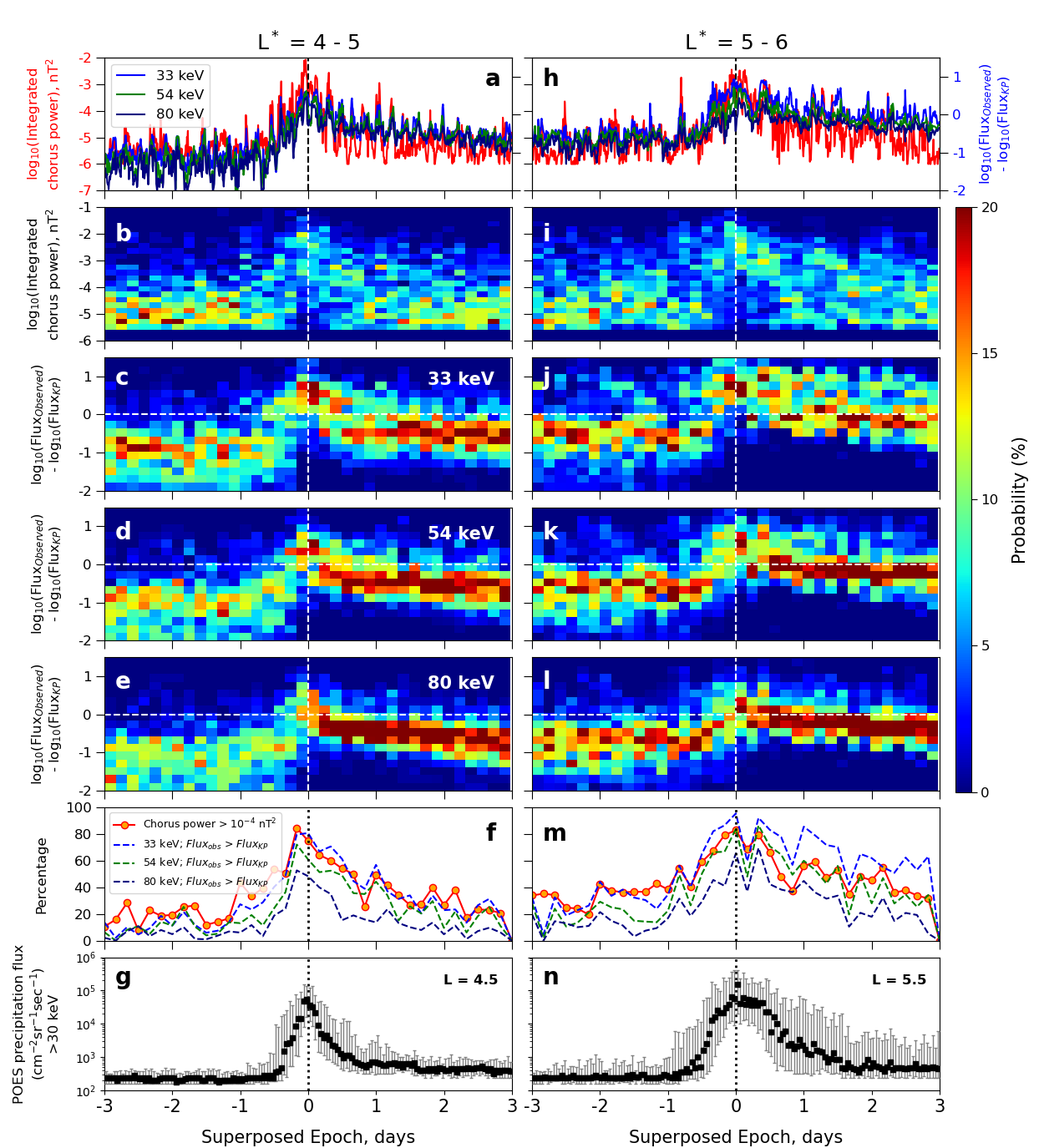
Figure 1: Median (a, h) integrated chorus wave power (nT2; red) and difference of observed and calculated KP limiting flux for 33 keV (blue), 54 keV (green), and 80 keV (navy) electrons; probability distribution function (PDF) of (b, i) integrated chorus wave power and difference of observed and KP limiting flux for (c, j) 33 keV, (d, k) 54 keV and (e, l) 80 keV electrons in logarithmic scale; (f, m) percentage of finding integrated chorus wave power> 10−4 nT2 and observed flux greater than KP limiting flux for 33 keV (blue), 54 keV (green) and 80 keV (navy) electrons within the L∗ range 4–5 (left panel) and 5–6 (right panel); and precipitating flux as observed by POES for > 30 keV electrons at (g) L = 4.5 and (n) L = 5.5 as a function of superposed epoch (in days) between 0 − 12 MLT. In each panel, the vertical dashed line marks the zero epoch, and the horizontal dashed lines in panels (c–e) and (j–l) indicate the observed flux being equal to the KP limiting flux. The colorbar at the right denotes the PDF so that the probability of finding events in each vertical slice adds up to 100%. In panels (g, n), the black scatter plot shows median electron flux and the error bars represent upper and lower quarterlies of the superposed epoch statistics.
Reference: Chakraborty, S., Mann, I.R., Watt, C.E.J., Rae, I.J., Olifer, L., Ozeke, L.G., Sandhu, J.K., Mauk, B.H., and Spence, H. Intense chorus waves are the cause of flux-limiting in the heart of the outer radiation belt. Sci Rep 12, 21717 (2022).https://doi.org/10.1038/s41598-022-26189-9.
Finding the Magnetopause Standoff Distance Using a Soft X-Ray Imager
By Andrey Samsonov (University College London)
The magnetopause standoff distance characterizes global magnetospheric compression and deformation in response to changes in the solar wind dynamic pressure and interplanetary magnetic field. We cannot derive this parameter directly from in situ spacecraft measurements because spacecraft cross the magnetopause rarely and in different regions along the magnetopause surface. However, it will be possible to obtain the time series of the magnetopause standoff distance in the near future using observations by soft X-ray imagers. In two companion papers (see below), we describe methods of finding the standoff distance from X-ray images. Soft X-rays are emitted in the magnetosheath and cusps as a result of charge exchange between heavy solar wind ions and exospheric neutrals. We use the results of MHD simulations to calculate the X-ray emissivity for different solar wind conditions. We simulate an artificial case with constant solar wind conditions and a case with an interplanetary coronal mass ejection (ICME) observed by the Wind spacecraft on 16-17 June 2012. Some MHD models predict relatively high density in the magnetosphere, larger than observed in the data. Correcting this, we develop magnetospheric masking methods to separate the magnetosphere from the magnetosheath and cusps.
We use the SXI_SIM numerical code developed at the University of Leicester to simulate the expected output of the Soft X-ray Imager (SXI) on board the forthcoming Solar wind Magnetosphere Ionosphere Link Explorer (SMILE) mission. Using the MHD results as input conditions, this code calculates the integrated emissivity along the Line-of-Sight (Ix) and SXI counts maps (see Figure 1). We verify the assumption that the maximum of the integrated emissivity is tangent to the magnetopause. Overall, the magnetopause is located close to the maximum Ix gradient or between the maximum Ix gradient and the maximum Ix depending on the method used. But since the angular distance between the maximum Ix gradient and the maximum Ix is relatively small (about 3°), the maximum Ix might be used as an indicator of the outer boundary of a wide magnetopause layer usually obtained in MHD simulations.
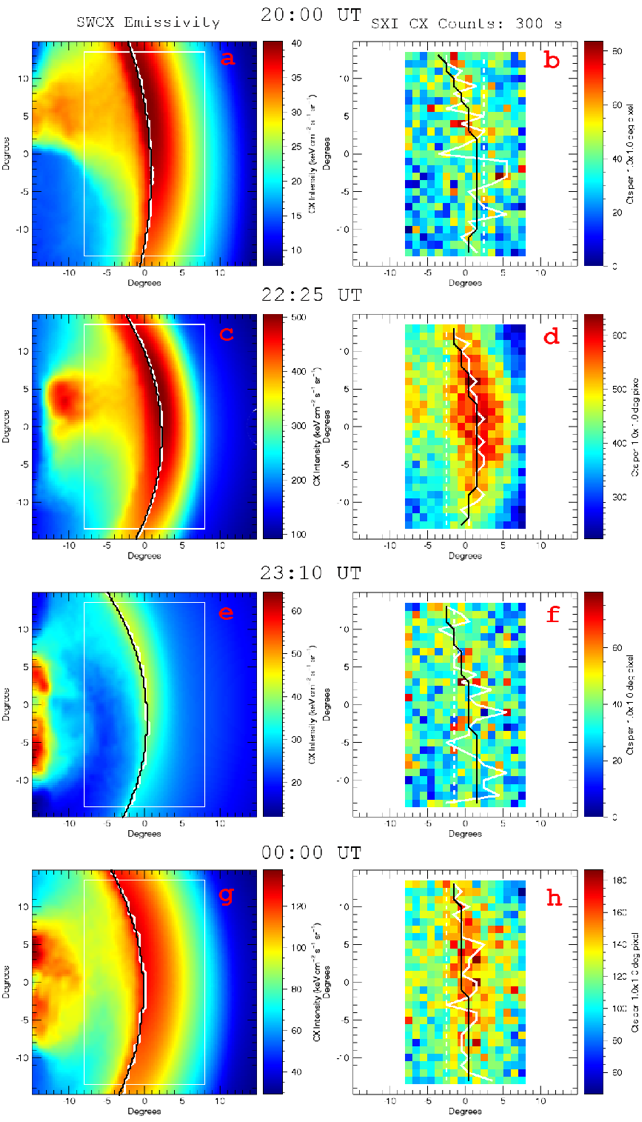
Original articles for further detail:
Samsonov, A., Carter, J. A., Read, A., Sembay, S., Branduardi-Raymont, G., Sibeck, D., & Escoubet, P. (2022). Finding magnetopause standoff distance using a soft X-ray imager: 1. Magnetospheric masking. Journal of Geophysical Research: Space Physics,
127, e2022JA030848. https://doi.org/10.1029/2022JA030848
Samsonov, A., Sembay, S., Read, A., Carter, J. A., Branduardi-Raymont, G., Sibeck, D., & Escoubet, P. (2022). Finding magnetopause standoff distance using a Soft X-ray Imager: 2. Methods to analyze 2-D X-ray images. Journal of Geophysical Research: Space Physics, 127, e2022JA030850. https://doi.org/10.1029/2022JA030850
LOFAR Observations of sub-structure within a Travelling Ionospheric Disturbance at mid-latitude
By Gareth Dorrian (Space Environment & Radio Engineering, University of Birmingham)
Travelling ionospheric disturbances (TID) are ubiquitous wave-like propagations in the Earth’s ionosphere and are the ionospheric counterpart of neutral atmospheric gravity waves (AGW). AGW can be driven by numerous sources from both the terrestrial and space weather domain such as sunrise, auroral sub-storms, volcanic eruptions, or thunderstorms. Terrestrial drivers from the lower atmosphere are coupled to the thermosphere by upwards propagation of AGW (Hines, 1960).
We study the ionosphere using LOFAR observations of trans-ionospheric radio propagation from compact natural radio sources. This is advantageous as, unlike most artificial satellites, natural radio sources are inherently broadband emitters and LOFAR is a broadband receiver with high frequency and time resolution. The behaviour of radio scattering through the ionosphere can thus be observed simultaneously across many frequencies.
Observations using the LOw Frequency ARray (LOFAR: van Haarlem et al., 2013) of trans-ionospheric radio propagation through a TID over the UK were made on 7 January 2019 (Figure 1). In LOFAR data, ionospheric variability manifests as rapid changes in the received signal from the radio source. Using this technique, internal sub-structure within the TID were clearly identified with dominant modes of oscillation on timescales of ~300s. At the observing geometries used these oscillations equated to sub-structure scale sizes of ~20 km. Contemporary GNSS and ionosonde data were used to provide the global parameters of the TID. At the observation frequencies used (25-65 MHz) the Fresnel scale is between 3-4 km; consequently the majority of the scattering features observed were lens-like refractions, rather than diffractive scintillation. Geomagnetic conditions at this time were very quiet, suggesting a terrestrial driver.
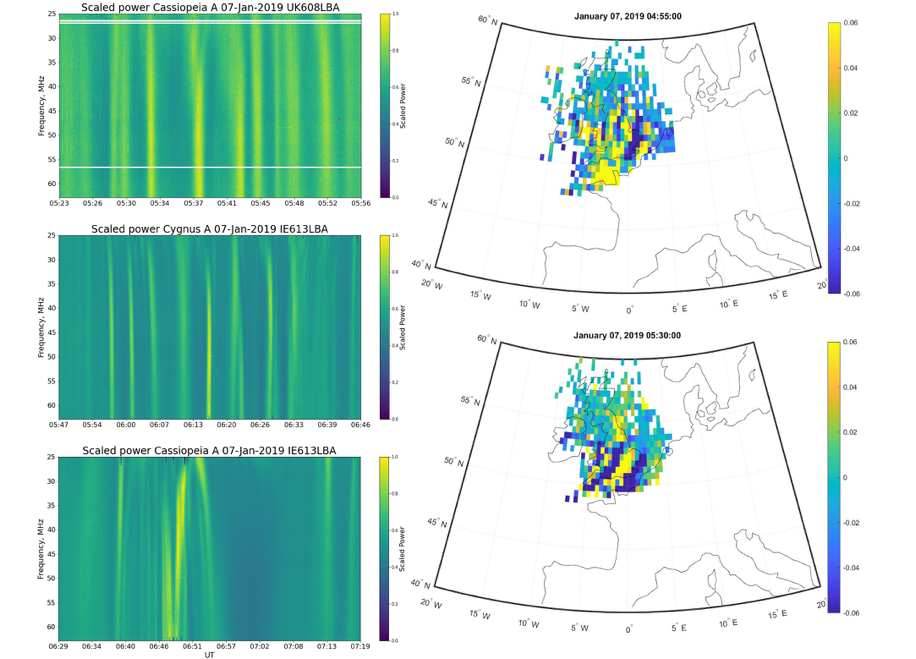
Figure 1: Left panels: LOFAR dynamic spectra from UK and Irish stations showing rapid variations in received signal power across the full observing band, caused by passage of TID internal substructure across raypath. Right panels: GNSS plasma anomaly maps from the observing period with the wave-like form of the TID clearly visible over the UK.
Original article for further details:
Dorrian, G., Fallows, R., Wood, A., Themens, D. R., Boyde, B., Krankowski, A., et al. (2023). LOFAR observations of substructure within a travelling ionospheric disturbance at mid-latitude. Space Weather, 21, e2022SW003198. https://doi.org/10.1029/2022SW003198
References:
van Haarlem, M. P., Wise, M. W., Gunst, A. W., Heald, G., McKean, J. P., Hessels, J. W. T., et al. (2013). LOFAR: Low-frequency-array. Astronomy and Astrophysics, 556, A2. https://doi.org/10.1051/0004-6361/201220873
Hines, C. O. (1960). Internal atmospheric gravity waves at ionospheric heights. Canadian Journal of Physics, 38(11), 1441– 1481. https://doi.org/10.1139/p60-150
Fine‐Scale Electric Fields and Joule Heating From Observations of the Aurora
By Patrik Krcelic (University of Southampton)
Optical measurements from three selected wavelengths have been combined with modelling of emissions from an auroral arc to estimate the magnitude and direction of small-scale electric fields on either side of an auroral arc for an event at 22:47:45 UT on 21 December 2014. The temporal resolution of the estimates is 0.1 s, which is much higher resolution than measurements from Super Dual Auroral Radar Network (SuperDARN) in the same region, with which we compare our estimates. The obtained electric fields have peak value of 88 ± 16 mV/m on the northern side of the arc and peak value of 66 ± 21 mV/m on the southern side of the arc. Additionally, we have used the Scanning Doppler Imager instrument to measure the neutral wind during the event in order to calculate the height integrated Joule heating. Joule heating obtained from small scale electric fields gives much larger values than that obtained from SuperDARN data. Results are briefly shown in the movie below, where the top two panels depict an observed and modelled auroral arc analyzed in current syudy, and the bottom plot depicts the evolution of Joule heating in time on each side of the auroral arc compared with the SuperDARN estimate. Our optical method for estimating electric fields, and consequently the Joule heating using ASK, has proven to be very valuable in understanding the local heating effects in the vicinity of auroral activity. Such high spatial and temporal resolution electric fields may play an important role in the dynamics of the magnetosphere-ionosphere-thermosphere system.
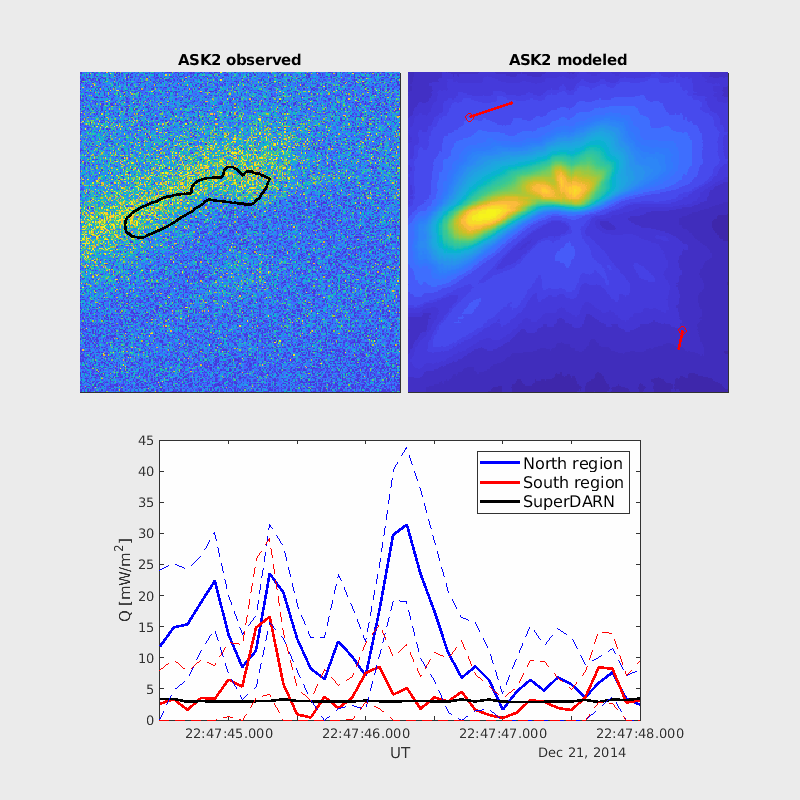
Original article for further detail:
Krcelic, P., Fear, R. C., Whiter, D., Lanchester, B., Aruliah, A. L., Lester, M., & Paxton, L. (2023). Fine-scale electric fields and Joule heating from observations of the aurora. Journal of Geophysical Research: Space Physics, 128, e2022JA030628. https://doi.org/10.1029/2022JA030628
Modeling the Time-Dependent Magnetic Fields That BepiColombo Will Use to Probe Down Into Mercury's Mantle
By Sophia Zomerdijk-Russell (Imperial College London)
The interior structure of a magnetised planet can be determined by using electromagnetic induction processes that results from solar-wind-driven magnetopause variability. To determine a profile of conductivity through depth within a planet, a broad spectrum of inducing fields is needed, as each discrete frequency will probe to a certain depth.
In preparation for the arrival of BepiColombo at Mercury in 2025, we have identified the opportunity to use Helios data to assess how solar wind ram pressure forcing can drive magnetopause variability at Mercury, as Helios took measurements during a similar phase of the Solar Cycle that BepiColombo is expected to see on its arrival. We find that Mercury’s magnetosphere is bombarded by a highly variable and unpredictable solar wind with a broad range of frequency signals and that the inducing field generated in response to the variable solar wind ram pressure is non-uniform across the planet’s surface.
A solar wind ram pressure time series from Helios measurements and the KT17 Hermean magnetospheric field model (Korth et al., 2017) were then used to generate a ram pressure driven inducing field spectra at two points on Mercury’s surface. In power spectra of these example inducing field spectra, frequency signals were found to peak between ~5.510-5 and 1.510-2 Hz. Heyner et al. (2021) determined that signals with these frequencies should penetrate into Mercury’s crust and mantle.
Particular orbital configurations of the BepiColombo mission will have MPO inside Mercury’s magnetosphere and Mio measuring the upstream solar wind, see Figure 1. Therefore, the dual spacecraft nature of the BepiColombo mission will be well suited to investigate Mercury’s magnetosphere’s response to external solar wind variability and allow a conductivity profile through to the mantle to be derived from observations of solar wind driven inducing field spectra with timescales seen in this work.
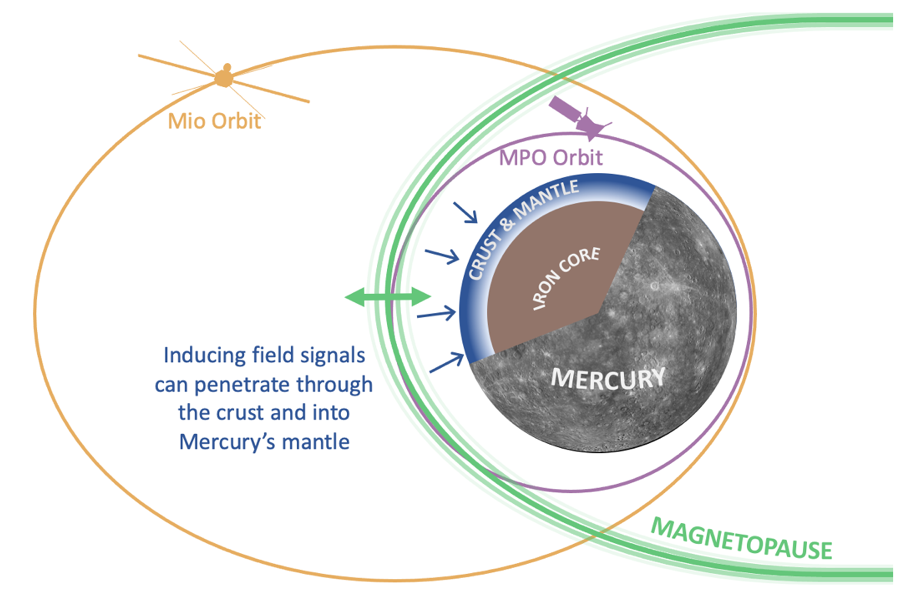
Original article for further detail:
, , , & (2023). Modeling the time-dependent magnetic fields that BepiColombo will use to probe down into Mercury's mantle. Geophysical Research Letters, 50, e2022GL101607. https://doi.org/10.1029/2022GL101607
References:
Heyner, D., Auster, H.-U., Fornaçon, K.-H., Carr, C., Richter, I., Mieth, J. Z. D., Kolhey, P., Exner, W., Motschmann, U., Baumjohann, W., Matsuoka, A., Magnes, W., Berghofer, G., Fischer, D., Plaschke, F., Nakamura, R., Narita, Y., Delva, M., Volwerk, M., … Glassmeier, K.-H. (2021). The BepiColombo Planetary Magnetometer MPO-MAG: What Can We Learn from the Hermean Magnetic Field? Space Science Reviews, 217(4), 52. https://doi.org/10.1007/s11214-021-00822-x
Korth, H., Johnson, C. L., Philpott, L., Tsyganenko, N. A., & Anderson, B. J. (2017). A Dynamic Model of Mercury’s Magnetospheric Magnetic Field. Geophysical Research Letters, 44(20), 10,147-10,154. https://doi.org/10.1002/2017GL074699